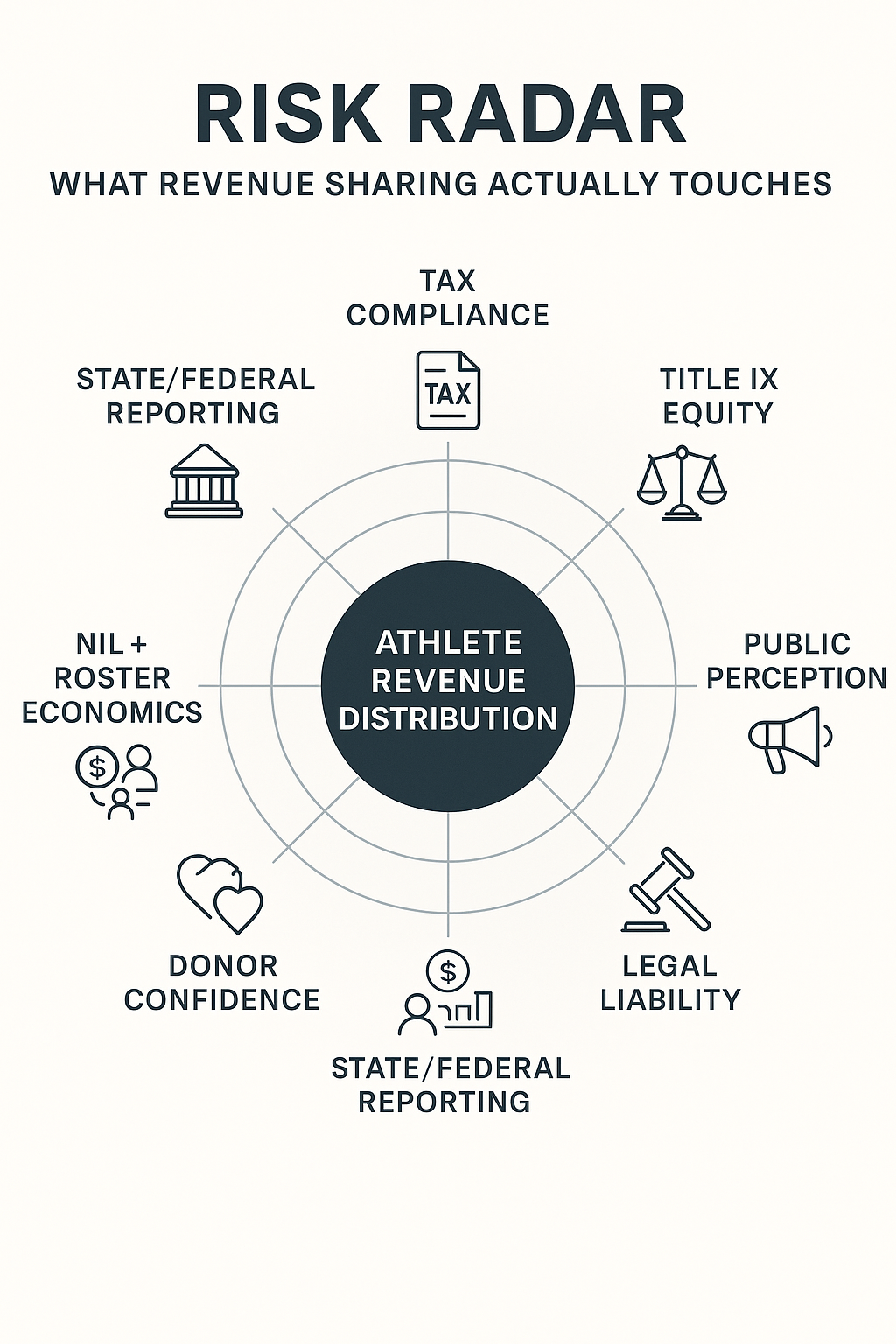The long-anticipated revenue-sharing era in college athletics is no longer theoretical. With the House v. NCAA settlement poised to unleash a tidal wave of financial responsibility onto institutions, Division I athletic departments must rapidly modernize their infrastructure to remain compliant, competitive, and credible. The most urgent challenge? Choosing the right system to handle athlete payment processing and the financial ecosystem that surrounds it.
This decision will not only affect how athletes get paid. It will fundamentally shape the trust student-athletes place in your department, the confidence donors and sponsors have in your operations, and your ability to compete in the open market for talent.
And if you’re treating it like an administrative afterthought, you’re already falling behind.
This Isn’t Just Payment Processing – It’s Financial Infrastructure
Let’s disabuse ourselves of the notion that this is simply about wiring money. Revenue share distribution is a deeply complex financial undertaking with implications across legal compliance, taxation, technology, and athlete welfare. Here are the foundational components that must be in place:
IRS Compliance & Tax Infrastructure
Revenue share payouts are taxable income. That means W-9s, 1099s, automatic withholding, quarterly filings, and audit-proof documentation. Departments must offer athletes tax support and administrators must have visibility into tax opt-ins and liability waivers. Getting this wrong is not an option.
“We’ve never had to build a payroll infrastructure for a population this young, this transient, and this decentralized,” said one P4 university CFO. “We’re essentially being asked to stand up a mini-financial institution inside an athletics department, and the exposure is enormous if we get it wrong—even once.”
Custom Payment Structuring
Revenue share agreements will likely mirror pro-style contracts. That means customized payout schedules, incentives, escalators, and even penalties. Automation and smart parsing of contract terms are essential to minimize human error and ensure efficient disbursement.
Regulatory & Title IX Tracking
Disparities in distribution open the door to scrutiny. It is vital that departments segment payments by sport, gender, and position, while maintaining compliance dashboards and disclosure alerts. This is particularly important when navigating Title IX obligations in a revenue-sharing environment.
Financial Forecasting & Cap Management
Future roster construction will resemble professional sports. Departments will need to model cap scenarios, evaluate ROI on athletes, and plan future roster moves based on both talent and budget. Fiscal strategy is now a core competency.
Cybersecurity & Data Protection
Athletics departments are now custodians of sensitive personal and financial data for hundreds of student-athletes. Data privacy standards such as SOC 2 and encryption frameworks are no longer optional. They are essential.
“You’re dealing with contracts, compensation, and IRS regulations involving hundreds of students, many of whom move frequently, don’t file taxes properly, or fall under multiple state jurisdictions,” added one university general counsel. “From a liability standpoint, this is a nightmare scenario unless every i is dotted and every t is crossed.”
Think About What Comes Next: The Future of Distribution
What if your revenue share system could do more than just pay athletes? What if it could transform how your department engages alumni, donors, and local businesses?
Imagine a feature that allows athletes to voluntarily donate a portion of their earnings back to the program, campus initiatives, or charitable causes. Not only could this reduce tax liabilities, but it would reframe athletes as philanthropic stakeholders. It also unlocks a future fundraising model rooted in shared value and long-term affinity.
Revenue-sharing could become revenue-returning. That kind of innovation changes the narrative.
From Spend Data to Strategic Partnerships
Athletics departments have long talked about monetizing the student-athlete ecosystem. Now they can. By tracking athlete spending behavior (e.g., where discretionary income is being used), departments can uncover valuable partnership insights.
If athletes are consistently spending a significant portion of their earnings at a local business, that’s leverage. You now have data to present in NIL negotiations or institutional sponsorships. Rather than guess what businesses to target, you’re operating with strategic intelligence.
Done right, this turns a compliance requirement into a revenue multiplier.
You’re Not Selecting a Vendor. You’re Choosing a System of Record.
The transition to a revenue-sharing model is bigger than any one legal case. It marks the beginning of a new era in college athletics—one where financial literacy, infrastructure, and transparency will separate the contenders from the casualties.
There are dozens of platforms that can deposit a check. But how many can:
✔ Educate athletes on long-term wealth?
✔ Prevent compliance failures before they happen?
✔ Model future roster economics?
✔ Handle multi-million-dollar payrolls across hundreds of individuals?
✔ Turn passive data into actionable revenue?
As Michael Haddix Jr., CEO of Scout, puts it: “We’re entering an era where athletic departments need to think like professional sports front offices—but without the staffing, experience, or infrastructure those organizations have spent decades building. When we started building this platform, we knew it couldn’t just be a wallet. It had to be a compliance engine, a tax framework, a forecasting tool, and an educational resource—all under one roof. Because once the first dollar moves, you better be ready to answer where it came from, where it went, and why.”
Make sure your decision aligns with where this industry is headed—not where it’s been.


